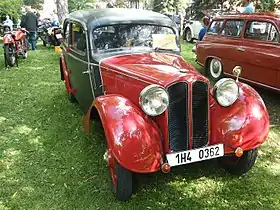| Jawa 700 | |
|---|---|
 Jawa 700 | |
| Overview | |
| Manufacturer | Jawa |
| Production | 1934–1937 |
| Assembly | Týnec nad Sázavou, Czechoslovakia |
| Body and chassis | |
| Body style | Sedan, roadster |
| Layout | Longitudinal front-engine, front-wheel drive |
| Powertrain | |
| Engine | 689 cc (42.0 in3) 2 stroke I2 |
| Transmission | 3 speed manual |
| Dimensions | |
| Wheelbase | 2,700 mm (106 in) |
| Length | 3,750 mm (148 in) (sedan) |
| Width | 1,500 mm (59 in) (sedan) |
| Height | 1,600 mm (63 in) (sedan) |
| Curb weight | 460 kg (1,014 lb) (chassis) 1,160 kg (2,557 lb) (sedan) |
| Chronology | |
| Predecessor | None |
| Successor | None |
The Jawa 700 was a car produced by Jawa in Czechoslovakia during the 1930s.
Background
František Janeček, the founder of the successful Czech motorcycle manufacturer Jawa, signed a license agreement with Jørgen Skafte Rasmussen of DKW on 20 July 1933 to produce the German company's cars in Czechoslovakia.[1] The first fruit of this agreement was the Jawa 700, based on the DKW F2 Meisterklasse, which was known internally as the 701.[2]
Design
The 700 was a front-wheel drive vehicle with a two stroke engine. It differed from its DKW parent in having a 10 cm (4 in) longer wheelbase and 20 cm (8 in) wheels. Unusually, as cars in Czechoslovakia drove on the left at the time, the car was left hand drive.[2]
Production
The 700 was launched at the 1934 Prague Motor Show.[1] Priced at 22,900 CSK in its four-seater guise, 1,002 vehicles were manufactured before production ceased in June 1937.[3]
Performance
The Jawa 700 could reach a top speed of between 85 and 90 km/h (53 and 56 mph) and had a typical fuel consumption of between 8 and 9 L/100 km (35 and 31 mpg‑imp; 29 and 26 mpg‑US).[1]